Why Switch from Fluorescent to LED Lighting for Energy Savings, Performance, and Environmental Benefits
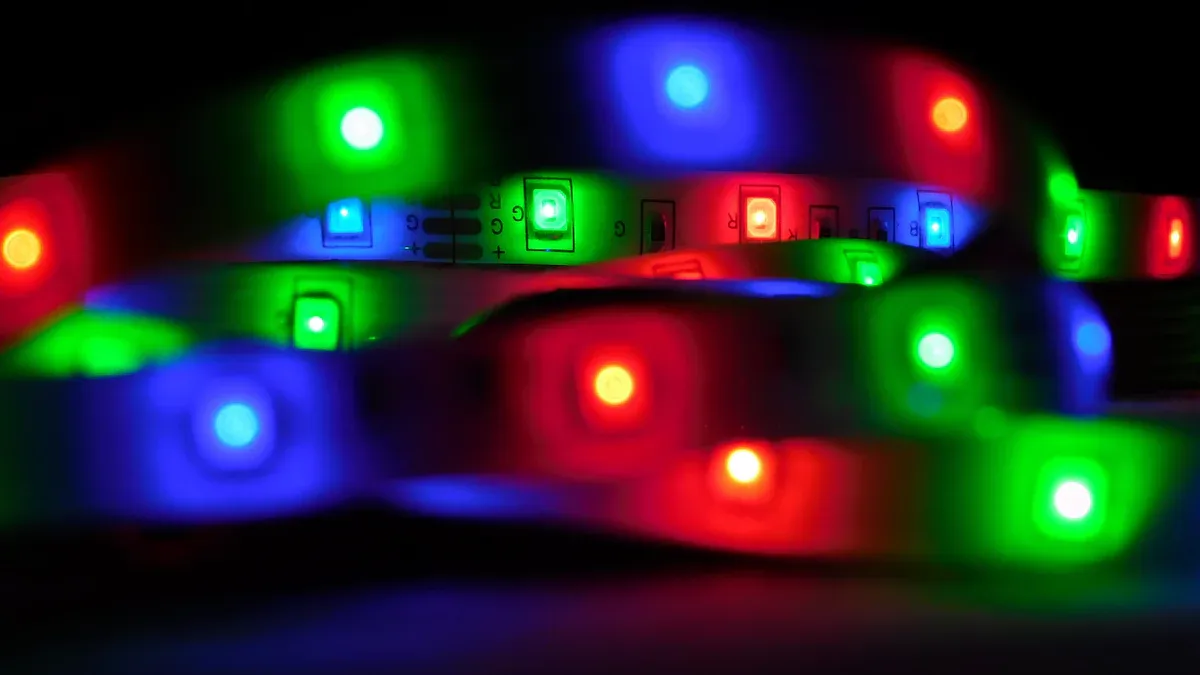
Switching to LED lights in your home not only improves brightness but also leads to significant energy savings. At our company, we are passionate about providing high-quality LED light products that help you pay less for power while benefiting the environment. Learn more about us and how our LED lighting solutions can brighten your home efficiently. Choosing our energy-saving LED lights is a smart decision for both your wallet and the planet. Our products reduce energy consumption and waste, helping to protect nature every day. Upgrade your home with our LED light products and experience the benefits of energy savings firsthand.
Key Takeaways
Changing to LED lights uses less energy and cuts your power bills fast. LED bulbs work for a much longer time than fluorescent bulbs, so you do not have to buy new ones often. LED lighting is brighter and looks more like real sunlight. It does not flicker, so your room feels nicer. LEDs are better for the earth because they do not have mercury and make less trash. You can swap old bulbs for LEDs easily and use smart LED features to save even more energy.
Energy Savings with LED Lights
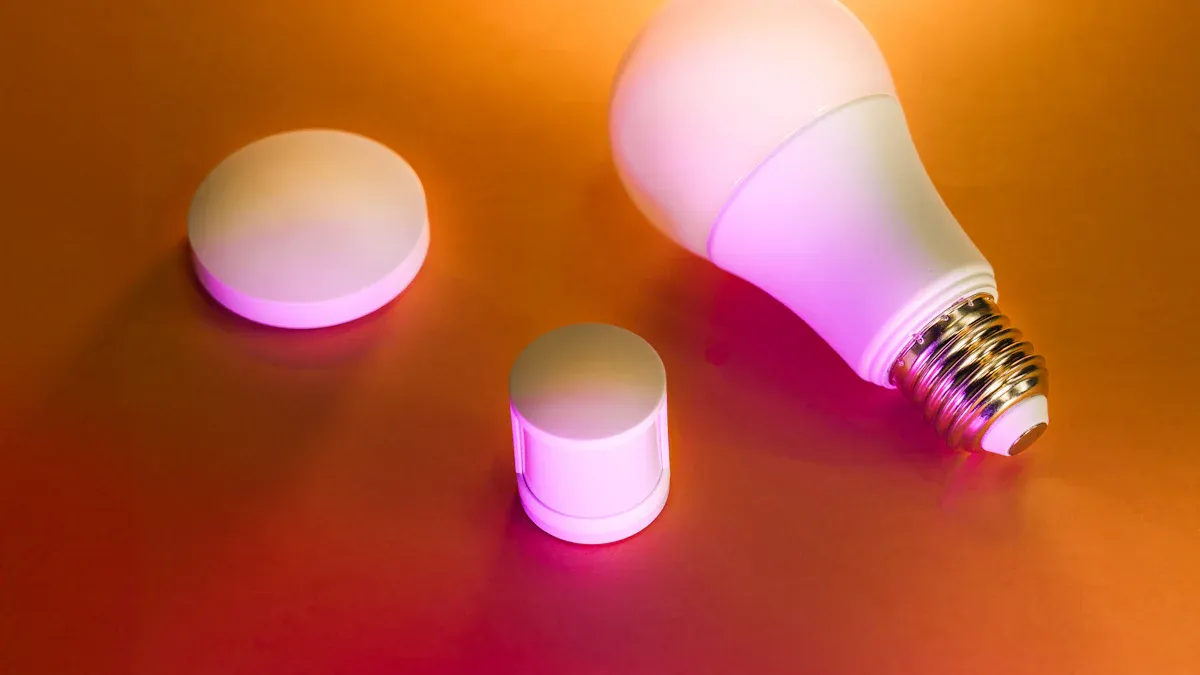
Lower Power Use
Switching from fluorescent lighting to LED lights saves a lot of energy. LED lighting uses much less power than regular bulbs. You use less electricity every time you turn on your lights. LED light bulbs turn more electricity into light, not heat. This means less energy is wasted. You still get the same or even better brightness. ENERGY STAR-rated LED lights are very efficient. You can trust them to save energy at home or work.
Reduced Utility Bills
When you use energy-efficient lighting, your bills go down. Many people and groups save a lot of money with LED lighting. Here are some examples:
Schools and colleges spend less than half on lighting after using LED lights.
Medical centers and retirement homes save between 50% and 70% on energy.
Grocery stores and city buildings pay less for electricity and save money over time.
These savings happen because you use less energy and need fewer replacements, so you keep more money.
You can get the same results with LED light bulbs in your space. The savings add up fast, so LED lighting is a good investment.
Efficiency Compared to Fluorescents
LED lights work better than fluorescent lighting in every way. Look at this table:
Light Type | Lumens per Watt Range | Efficiency Comparison |
|---|---|---|
LED Lights | ~130 | Baseline |
Fluorescent Lights | 50 to 100 | 30% to 160% less efficient than LEDs |
LED lights give about 130 lumens per watt. Fluorescent lighting gives only 50 to 100 lumens per watt. This means LED lighting is much more efficient. You get more light for each bit of energy you use. LED lights also use up to 40% less energy than fluorescent lights. This helps you save even more. With this efficiency, you get brighter rooms and lower costs.
Tip: Pick ENERGY STAR-certified LED lighting for the best efficiency and savings.
Switching to LED lighting is an easy way to save energy at home or work. You pay less for electricity, use less energy, and save money for a long time. Try LED lights and see the difference.
Performance Improvements
Longer Lifespan
Everyone wants lights that last a long time. LED lights can last up to 25 times longer than regular bulbs. You will not have to change them as often. This means you do not need to go to the store a lot. LED lighting keeps working for years, so you save time and money. You can count on your LED light bulbs to work well, even in hard places. Because they last so long, you get more for your money.
Better Light Quality
You should have good light in every room. LED lighting gives you brighter and more natural light. Colors look real and bright, not faded or dull. The Color Rendering Index (CRI) tells how well a light shows colors. Good LED lights usually score over 90 on the CRI scale. Fluorescent lights often score under 80. Look at this table to see the difference:
CRI Range | Color Rendering Quality Description | Typical Light Source Example |
|---|---|---|
95 - 100 | Phenomenal color rendering; colors appear natural and vibrant; subtle tones and skin tones look excellent. | High-quality LED lighting (e.g., UltraBright™ Render Series) |
90 - 95 | Great color rendering; most colors 'pop' and are easily distinguishable; vibrant and fully saturated appearance. | High-quality LED lighting |
80 - 90 | Good color rendering; most colors rendered well but less saturated; acceptable for many commercial uses. | Some fluorescent lighting and lower-grade LEDs |
Below 80 | Poor color rendering; colors appear desaturated, drab, and sometimes indistinguishable (e.g., black vs navy socks). | Typical fluorescent lighting |
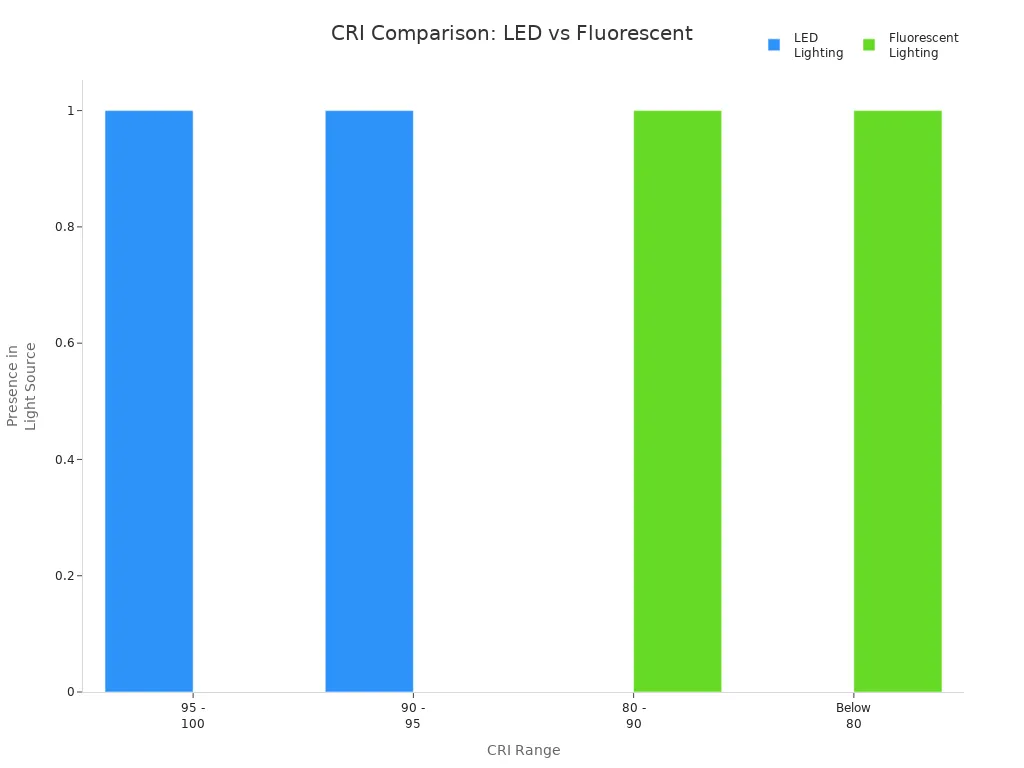
LED lighting helps your space look great with better light.
Instant-On and No Flicker
You want lights that turn on right away. LED lights shine at full brightness as soon as you flip the switch. There is no waiting for them to warm up. You also do not have to deal with flickering. Flicker-free LED lighting is easier on your eyes. You can read, work, or relax without feeling tired. Studies show that flicker-free lights help you focus better. You always get steady, clear light.
Tip: Pick flicker-free LED lighting for more comfort and to help you get more done.
Versatility
LED lighting works for almost any job. You can use it inside or outside, in hot or cold places, and even with smart home systems. LED lights work well in bad weather, freezers, museums, and solar-powered spots. See how LED lighting does better than fluorescent in many places:
Application Area | LED Advantage Description |
|---|---|
Outdoor Lighting in Harsh Conditions | LEDs are highly durable, resistant to shock, vibrations, weather, and vandalism, making them suitable for outdoor use in rough environments such as construction sites and public areas. |
Cold Environments (e.g., Freezer Rooms) | LEDs operate effectively in extremely low temperatures where fluorescent lights may fail or perform poorly. |
Traffic and Signal Lights | LEDs provide instant illumination and tolerate frequent switching without reducing lifespan, unlike fluorescents that have delayed start and reduced life with frequent on/off cycles. |
Museums and Galleries | LEDs emit almost no UV light, protecting UV-sensitive objects and materials from damage, unlike fluorescent lighting. |
Remote or Solar-Powered Locations | LEDs operate on low voltage, enabling easy integration with solar power and use in remote or rural areas. |
Focused Light Applications | LEDs can direct light precisely without external reflectors, improving efficiency in targeted lighting scenarios. |
You can put LED lighting almost anywhere you want. This makes LED lights a smart choice for homes and businesses.
Environmental Benefits of Upgrading to LED Lighting
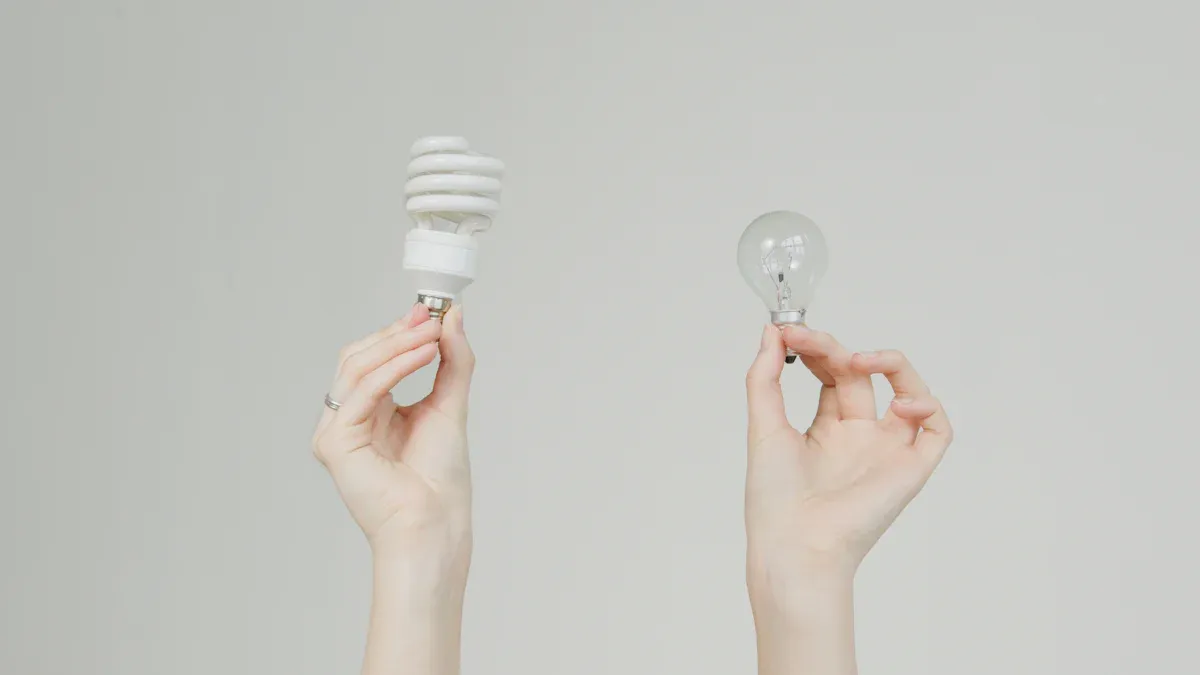
Mercury-Free Design
LED lighting helps keep you and nature safe. Fluorescent bulbs have mercury inside them. Mercury is very dangerous for people and animals. If it gets out, it can hurt the environment. You must be careful when throwing away fluorescent bulbs. Some places have special drop-off spots for these bulbs. For example, Massachusetts has collection maps for mercury bulbs. You need to follow rules to avoid pollution. LEDs do not have mercury, so you do not have this problem. You do not need to worry about leaks or hard disposal steps. LEDs are safer and better for the planet.
Note: Using LEDs keeps harmful stuff out of landfills and water.
Less Waste
Switching to LED lighting means you make less trash. LEDs last much longer than fluorescent bulbs. You will throw away fewer bulbs over time. You also avoid waste from broken glass and dangerous materials. Look at this table to see how LEDs make less waste than fluorescent lighting:
Lighting Type | Lifespan (Hours) | Contains Hazardous Materials | Waste Generation Over Time | Maintenance Needs |
|---|---|---|---|---|
LED | Up to 100,000 | No | Very Low | Minimal |
Fluorescent | 7,000 – 15,000 | Yes (Mercury) | High | Frequent |
You can see the difference right away. LEDs can last up to 100,000 hours. Fluorescent bulbs burn out much faster. You need to replace them more often. This means more bulbs end up in the trash. LEDs help you make less waste and support green habits.
Lower Carbon Footprint
LED lighting helps fight climate change. LEDs use about half the energy of compact fluorescent lights. They use up to 90% less energy than old incandescent bulbs. Most of the power in LEDs turns into light, not heat. This means you use less electricity. Power plants do not need to make as much energy. This helps lower greenhouse gas emissions and makes the air cleaner. Experts say that if more people use LEDs, we could cut global CO2 by 15.69 gigatons by 2050. LEDs also help bring clean light to places that use dirty fuels like kerosene. This helps everyone have a smaller carbon footprint.
You lower carbon every time you use an LED.
You help make the air cleaner for everyone.
You support the environment and your community.
Recyclability
Recycling your old LED lights helps the planet. Many recycling programs now take LEDs. They can get back useful things like aluminum and rare earth metals. These programs make it easy to recycle LEDs. You do not need to worry about dangerous chemicals. Recycling LEDs is safe and simple. Fluorescent bulbs are harder to recycle. Special places must handle the mercury and powder inside. This costs more and makes recycling harder. With LEDs, recycling is easy and good for the earth. You help keep trash out of landfills and support green habits.
Tip: Ask your local recycling center if they take LEDs. Recycling right helps keep the earth clean and healthy.
The Big Picture: Your Impact
Choosing LED lighting helps you cut waste, lower carbon, and protect nature. The good things about LED lighting go beyond your home or business. If more people use LEDs, there will be less pollution and less trash. The planet will be healthier for everyone. You join a worldwide effort to help the earth. Switch to LEDs and enjoy the benefits for many years.
Cost Savings and Incentives
Upfront vs. Long-Term Costs
You may think LED lighting costs too much at first. But you start saving money almost right away. If you change 100 fluorescent bulbs to LED bulbs, it costs about $4,000. Each year, you save $70.56 for every light. This comes from using less energy, less HVAC, and less work. For 100 lights, you save $7,056 every year. You get your money back in just over six months. After that, all the money you save is extra.
Here is a table that shows the numbers for homes and businesses:
Setting | Upfront Cost (USD) | Annual Savings (USD) | Payback Period (Years) | Net Profit Over 10 Years (USD) | Additional Benefits |
|---|---|---|---|---|---|
Residential | $1,200 | $320 | 3.75 | N/A | Lower maintenance, modern looks |
Commercial | $40,000 (before rebates) | $23,000 | 1.5 | $27,600 | Rebates, tax breaks, less maintenance |
You can see that saving money over time is much better than the first cost. LED upgrades help both homes and businesses save real money.
Maintenance Savings
LED lighting lasts much longer than old bulbs. You do not have to change bulbs or ballasts as much. This means you spend less time and money fixing lights. Businesses save a lot because they do not need as many repairs. They also have less downtime. For example:
LED fixtures mean you do not need to replace lights often.
You save on labor because workers do not change bulbs as much.
One business saved $1,100 each year by changing just 25 fixtures to LED.
Lower maintenance costs help you get your money back faster.
Tip: Less time fixing lights means more time for important work.
Rebates and Tax Credits
You can save even more money with rebates and tax credits. Many states and power companies have programs to help you switch to LED lighting. These programs lower your first costs and help you get your money back sooner. Here are some programs you can use:
Region/State | Program Name | Administering Organization | Application Link |
|---|---|---|---|
New Jersey | New Jersey Clean Energy Program | State of New Jersey Board of Public Utilities | |
New York | Savings for Small-Medium Business Customers | Con Edison Commercial | |
Oregon | Equipment Upgrades + Retrofits Incentive Program | Energy Trust of Oregon | energytrust.org |
Pennsylvania | BIZ SAVE | PECO Energy Co |
You can also get rebates for different LED fixtures:
LED Fixture Type | Average Rebate Amount (USD) |
|---|---|
LED Tubes | $4 per tube |
2x4 Troffers | $33 per fixture |
Parking Garage Fixtures | $94 per fixture |
HID Screw-in Bulbs / Corncobs | $53 per bulb |
Pole Lights | $135 per light |
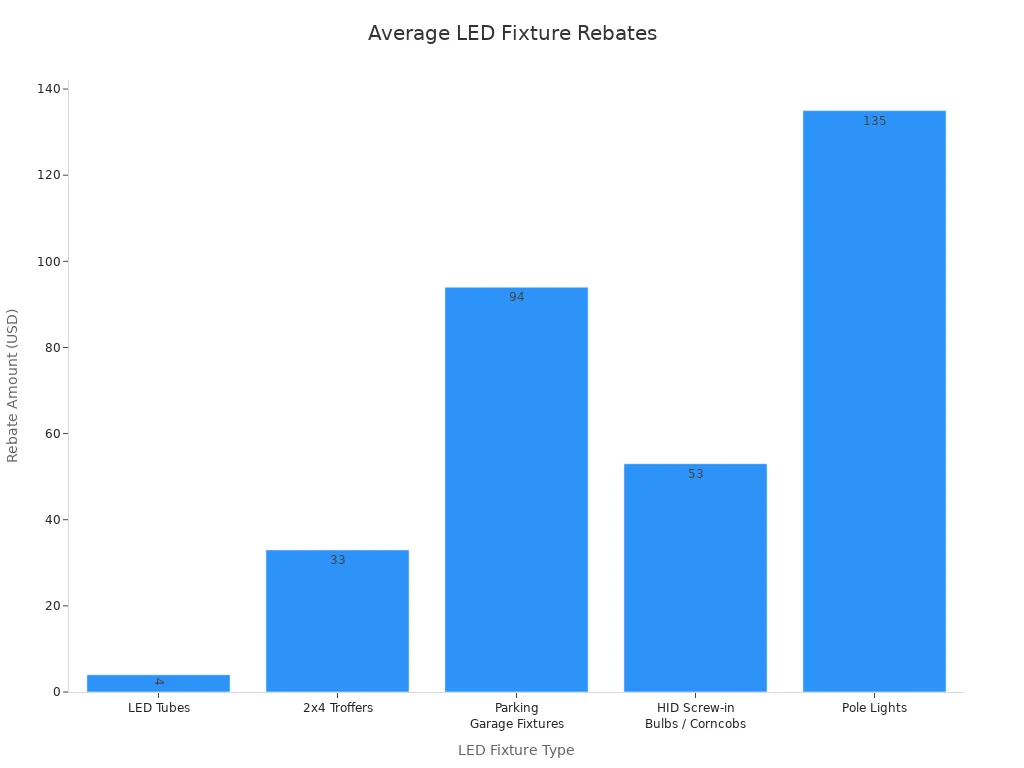
Government and utility programs make LED upgrades cheaper. You get your money back faster and save more in the long run. Use these programs to save as much as you can.
Practical Considerations for Energy-Efficient Lighting
Easy Replacement
You do not have to worry about a hard process when you switch old bulbs for LEDs. Most LED bulbs fit into the lights you already have. Just take out the old bulb and put in the new LED. You do not need special tools or skills. Many LED bulbs come with simple instructions. You can finish the job in just a few minutes. This fast change lets you start saving energy right away.
Tip: Always turn off the power before changing any light bulb to stay safe.
Fixture Compatibility
You want your new lights to fit your old fixtures. LED bulbs come in many shapes and sizes. You can find LEDs for table lamps, ceiling lights, and outdoor lights. Some LEDs work with dimmer switches, so you can change how bright they are. Look at the box to see if the bulb works with your fixture. If you have a special fixture, look for a special LED bulb. There are even LEDs for recessed and track lighting.
Here is a quick guide:
Fixture Type | LED Compatibility | Notes |
|---|---|---|
Table/Floor Lamps | Yes | Standard base fits most lamps |
Ceiling Fixtures | Yes | Many shapes available |
Outdoor Fixtures | Yes | Weather-resistant options |
Dimmers | Check label | Use dimmable LEDs |
You can use energy-saving lights in every room.
Smart Features
LED bulbs can do more than just light up a room. Many new LED bulbs have smart features. You can control your lights with your phone or your voice. You can set times for lights to turn on or off. You can change the color or brightness from anywhere. Some smart LEDs work with Alexa or Google Home. You can even set your lights to turn on when you get home. These features help you save energy and make life easier.
Smart lighting helps your home feel safer and more comfortable. Try it and see how it works.
You can save money, enjoy better light, and help the planet by upgrading to led lighting. This switch gives you long-lasting bulbs, lower bills, and a safer home. You make an environmentally friendly choice that supports a cleaner world. Take a look at your current lights. Replace them with led lighting for instant and long-term rewards. Make the smart move today!
FAQ
How much money can you save by switching to LED lighting?
You can save up to 70% on your lighting bills. LED bulbs use less energy and last longer. You spend less on replacements and repairs. Over time, these savings add up fast.
Are LED lights safe for your eyes?
Yes, LED lights are safe. They do not flicker or buzz like old bulbs. You get steady, bright light that helps you read and work without eye strain.
Tip: Choose LED bulbs labeled "flicker-free" for the best comfort.
Can you use LED bulbs in your current fixtures?
Most LED bulbs fit right into your existing fixtures. You do not need special tools or wiring. Just check the bulb size and base before you buy.
Table lamps
Ceiling lights
Outdoor fixtures
All work with LED bulbs.
Do LED lights really help the environment?
Absolutely! LED bulbs use less power and last longer. You throw away fewer bulbs. LEDs do not contain mercury, so you help keep harmful chemicals out of landfills.
Every LED bulb you use makes a positive impact on the planet.
See Also
Comparing Low Pressure Sodium And LED Lights For Efficiency
Advantages Of LED Street Bulbs In Energy And Installation
Energy And Cost Comparison Between LED And Traditional Streetlights
Key Features And Benefits Of GE LED Light Bulbs Explained
Comprehensive Guide To LED Street Light Technology And Benefits

